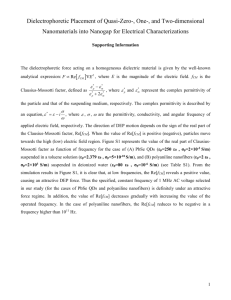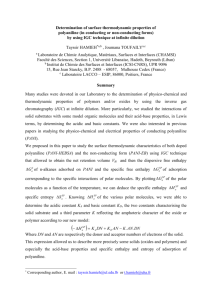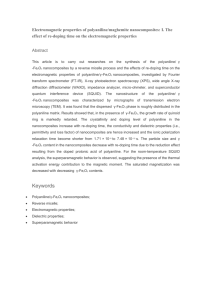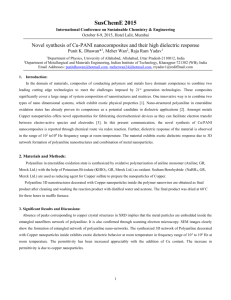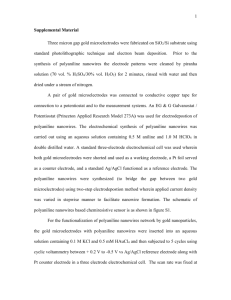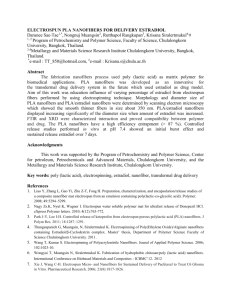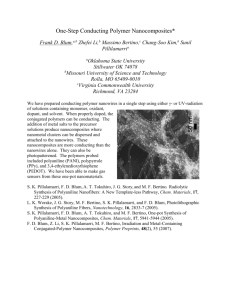pdf file
advertisement
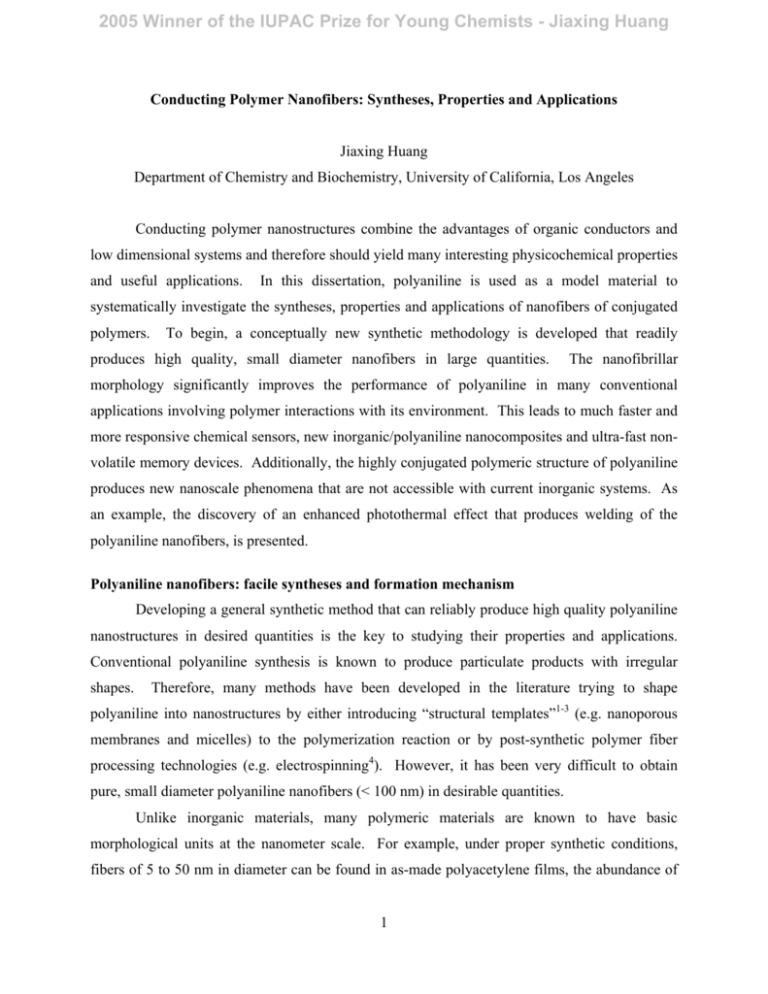
2005 Winner of the IUPAC Prize for Young Chemists - Jiaxing Huang Conducting Polymer Nanofibers: Syntheses, Properties and Applications Jiaxing Huang Department of Chemistry and Biochemistry, University of California, Los Angeles Conducting polymer nanostructures combine the advantages of organic conductors and low dimensional systems and therefore should yield many interesting physicochemical properties and useful applications. In this dissertation, polyaniline is used as a model material to systematically investigate the syntheses, properties and applications of nanofibers of conjugated polymers. To begin, a conceptually new synthetic methodology is developed that readily produces high quality, small diameter nanofibers in large quantities. The nanofibrillar morphology significantly improves the performance of polyaniline in many conventional applications involving polymer interactions with its environment. This leads to much faster and more responsive chemical sensors, new inorganic/polyaniline nanocomposites and ultra-fast nonvolatile memory devices. Additionally, the highly conjugated polymeric structure of polyaniline produces new nanoscale phenomena that are not accessible with current inorganic systems. As an example, the discovery of an enhanced photothermal effect that produces welding of the polyaniline nanofibers, is presented. Polyaniline nanofibers: facile syntheses and formation mechanism Developing a general synthetic method that can reliably produce high quality polyaniline nanostructures in desired quantities is the key to studying their properties and applications. Conventional polyaniline synthesis is known to produce particulate products with irregular shapes. Therefore, many methods have been developed in the literature trying to shape polyaniline into nanostructures by either introducing “structural templates”1-3 (e.g. nanoporous membranes and micelles) to the polymerization reaction or by post-synthetic polymer fiber processing technologies (e.g. electrospinning4). However, it has been very difficult to obtain pure, small diameter polyaniline nanofibers (< 100 nm) in desirable quantities. Unlike inorganic materials, many polymeric materials are known to have basic morphological units at the nanometer scale. For example, under proper synthetic conditions, fibers of 5 to 50 nm in diameter can be found in as-made polyacetylene films, the abundance of 1 2005 Winner of the IUPAC Prize for Young Chemists - Jiaxing Huang which is determined by polymerization kinetics.5 In this dissertation, the basic morphological unit for polyaniline is discovered to be nanofibers with diameters of tens of nanometers. These nanofibers naturally form in the early stage of the polymerization reaction and are much smaller in diameter than most of the templated or electrospun fibers. In conventional polymerization, overgrowth of polyaniline on these nanofiber scaffolds leads to the final irregularly shaped micron sized particulates (Figure 1).6 Therefore, in contrast to previous work in which preparation conditions were designed to “shape” the polymer into nanostructures, this work takes advantage of the ultra-small nanofibrillar morphological unit and focuses on modifying the reaction pathway so that nanofiber formation is favored while their overgrowth, which would otherwise lead to irregularly shaped agglomerates, is suppressed. a b c initiator monomer 25 min 100 min Figure 1. The morphological evolution of polyaniline during chemical polymerization (a) is explored by electron microscopy. It clearly shows that nanofibers (green lines) are produced in the early stages of polymerization (b) and then turn into large, irregularly shaped agglomerates (c) due to secondary growth. Two basic approaches to separate nanofiber formation from overgrowth in conventional polyaniline polymerization reactions have been discovered. In the first approach, the polymerization reaction is placed in a heterogeneous biphasic system, where the polymerization occurs only at the interface (Figure 2).7,8 Since the as-made polyaniline product is 2 2005 Winner of the IUPAC Prize for Young Chemists - Jiaxing Huang Figure 2. Snapshots showing the interfacial polymerization route to polyaniline nanofibers. The reaction times are a) 0, b) 60, c) 120 and d) 180 seconds. The top layer is an aqueous solution of acid and oxidant, the bottom layer is aniline dissolved in an organic solvent. e) is a typical electron microscopy image of the nanofiber products. synthesized in its hydrophilic emeraldine salt form, it diffuses away from the reactive interface into the water layer. This makes more reaction sites available at the interface and avoids further overgrowth. In this way, the nanofibers formed at the interface are collected in the water layer without severe secondary overgrowth. Another method to prevent overgrowth is to stop the polymerization as soon as the nanofibers form. This has now been achieved by rapidly mixing the monomer and initiator solutions (Figure 3).6 When the reaction starts, the initiator molecules are consumed rapidly during polymerization and depleted after nanofiber formation. Therefore, the overgrowth of polyaniline is suppressed due to lack of initiator molecules. Figure 3. Schematic illustration showing a rapidly mixed reaction in which (a) the initiator and monomer solutions are rapidly mixed together all at a time. Therefore (b to c) the initiator molecules are depleted during the formation of nanofibers, disabling further polymerization leading to overgrowth. The synthetic methodology to polyaniline nanofibers presented here is conceptually different from previous work and is much simpler and more effective. Following our methods, it is now possible to make large-scale, high-quality nanofibers in essentially any chemical laboratory, which should lead to the discovery of many exciting properties and applications such as those described in the following sections. It should also provide important insights into the synthesis of other polymeric materials and even inorganic nanostructures. 3 2005 Winner of the IUPAC Prize for Young Chemists - Jiaxing Huang Polyaniline nanofiber based chemical vapor sensors The conjugated polymer polyaniline is a promising material for sensors9 (see Figure 4 a,b for sensor structure) since its conductivity is highly sensitive to chemical vapors. Most polyaniline sensor research has focused on chemically modifying the polymer structure to facilitate interactions between vapor molecules and polymer. However, little work has been done so far to minimize the diffusional path length for vapor molecules; yet poor diffusion can readily outweigh any improvements made to the polymer chains since most of the material other than the limited number of surface sites is unavailable for interacting with the vapor, thus degrading sensitivity (Figure 4a). This problem can be solved by using nanofibers of polyaniline. For example, improvements in both sensitivity and time response of many orders of magnitude are now observed by this simple morphological change to the polymer (Figure 4c).7,10 A great variety of chemical vapors including hydrochloric acid, ammonia, organic amines, hydrazine, chloroform, methanol, hydrogen sulfide, etc. have been tested and categorized. Five different mechanisms have been elucidated. For each mechanistic type, significantly enhanced performance of nanofiber films over conventional materials is observed.11 The 3-D open structure of the nanofiber films also leads to some novel sensing properties. For example, for conventional film sensors the response is strongly affected by the film thickness, however, the response of the porous nanofiber films is essentially thickness independent (Figure 5).7,10 Vapor 1 1.0 -2 0.5 1x10 -4 0 10 -6 10 -8 R/R0 10 0 0 500 1000 Time / s 20 40 1500 Figure 4. Schematic illustration showing (a) a polyaniline chemiresistor sensor and (b) a piece of nanofiber coated electrodes. On exposure to 100 ppm of HCl vapor, (c, solid line) the response of the nanofiber film is 6 orders of magnitude higher than that of (c, dotted line) a conventional polyaniline film. The time response of the nanofiber film is ~2 s, while that of the conventional film is ~40 s (see inset of c). 4 2005 Winner of the IUPAC Prize for Young Chemists - Jiaxing Huang 100 ppm HCl -1 -3 0.7 µm -5 1x10 -3 10 R/ R0 R/R0 10 -5 1x10 0.3 µm -7 10 -7 10 -9 10 0 0.2 µm 0.4 µm 2.0 µm -1 10 1.0 µm 10 500 1000 Time (s) 0 1500 500 1000 Time (s) 1500 Figure 5. The response of conventional polyaniline films to chemical vapors is heavily dependant on thickness (left) while the response of nanofiber films (right) is essentially not affected by thickness due to their highly porous, open structure. Due to the ease of the synthetic methods developed, sufficient nanofiber material is now readily available for chemical sensor applications. This should make polyaniline nanofibers a model material for sensor research as well as chemical/materials education. For example, a polyaniline nanofiber sensor laboratory has been incorporated into the Materials Chemistry Laboratory Class (Chem 185/285) in the UCLA Department of Chemistry and Biochemistry.12,13 Students with no previous background in polymers or sensors can learn the synthesis of polyaniline nanofibers, the construction of a simple sensing system and the rapid detection of chemical vapors through a 3-day laboratory assignment. Polyaniline nanofiber based nanocomposites Polyaniline nanofibers can be used as a template to guide the growth of inorganic nanoparticles and confine them in the polymer matrix. The small diameters and uniform size of the nanofibers lead to many previously unattainable nanofiber based inorganic/polymer nanocomposites. Such composites are very promising in applications including biosensing, catalysis, nanoelectronics and scaffolds for tissue engineering. For example, metal-polyaniline composites can be readily made by direct reaction between polyaniline and oxidative metal ions. With polyaniline nanofibers the size of the metal particles and their distribution in the polymer matrix can be well controlled which is very difficult, if not impossible in conventional metalpolyaniline composites. Using our polyaniline nanofibers, metal nanoparticles such as Au, Ag, Pt, Pd, etc. can be grown along the nanofibers uniformly.10 The size and distribution of the metal nanoparticles are controllable as shown in Figure 6. Two distinct nanocomposites have been created. In the first case, 10 to 50 nm size Au nanoparticles are grown on the surface of the 5 2005 Winner of the IUPAC Prize for Young Chemists - Jiaxing Huang nanofibers decorating them to form a “nanoparticle-ON-nanofiber” structure, which is potentially very useful for biosensor applications. In the second case, 3-6 nm size Au nanoparticles are embedded inside the nanofibers forming an unusual “nanoparticle-INnanofiber” nanocomposite. This type of composite material is the key to a novel non-volatile molecule memory device we recently demonstrated.14 Such polyaniline based memory devices (PANI-MEM) have nanosecond switching times, high on/off ratios and low manufacturing costs, making them very promising for faster and less expensive data storage media than what’s currently available (e.g. flash memory). Figure 6. Polyaniline nanofiber assisted growth of metal nanoparticles leading to (a) “dot-ON-fiber” and (b) “dot-IN-fiber” types of nanocomposites which would be useful for applications such as disease diagnosis sensors and ultrafast non-volatile memory devices, respectively. Besides metal nanoparticles, it is also possible to synthesize inorganic compounds on the nanofibers using in-situ metathesis reactions. For example, metal sulfides can be made through a reaction between metal salts and hydrogen sulfide. Therefore, if one of the reactants is first incorporated into the polyaniline nanofibers as dopant and then exposed to the other, metal sulfides will form along the polyaniline nanofibers where the metathesis reactions occur. This idea has recently led to our invention of an H2S gas detector using metal salt modified polyaniline nanofibers, where the formation of metal sulfide produces a strong electrical signal.15 6 2005 Winner of the IUPAC Prize for Young Chemists - Jiaxing Huang Flash welding of conducting polymer nanofibers The nanoscaled structure of polyaniline nanofibers produces enhanced polymer functionalities; their polymeric nature also yields new nanoscale physicochemical phenomena that have not been observed in inorganic nanostructured materials.16 In this dissertation, a flash welding technique is presented based on an enhanced photothermal effect discovered with the polyaniline nanofibers (Figure 7). Photothermal Welding effect Flash welding Figure 7. Polyaniline nanofibers can be welded together (bottom) on exposure to a camera flash due to locally confined heat produced by an enhanced photothermal effect (top). When polyaniline is exposed to light, it converts most of the absorbed energy into heat due to its high photothermal conversion efficiency. In polyaniline nanofibers, the heat generated through photothermal processes will be confined within the individual nanofibers (Figure 7, top) since polyaniline, as well as other polymeric materials, is a poor heat conductor. This enables unprecedented photothermal effects that cannot be observed in either bulk polyaniline or inorganic nanomaterials. A camera flash is found to cause instantaneous welding of conducting polymers.17 Under flash irradiation, polyaniline nanofibers instantly “melt” to form a smooth and continuous film from an originally random network of nanofibers (Figure 7, bottom). This flash welding technique can lead to many exciting potential applications (Figure 8). For example, when a nanofiber film is flashed, only the exposed side is welded while the unexposed side is intact. Therefore, a free-standing asymmetric membrane can be created directly from a nanofiber powder film (Figure 8a). Such films are very important for industrial separations. Since the welded film becomes smoother and reflects more light, flash welding can be used to 7 2005 Winner of the IUPAC Prize for Young Chemists - Jiaxing Huang imprint patterns into nanofiber films by using a photomask (Figure 8b). Moreover, the heat generated during flash irradiation can also weld polyaniline to another polymer such as polystyrene (Figure 8c) or even Teflon (polytetrafluoroethylene). Flash welding thus enables a wide range of potential applications from forming asymmetric nanofiber films to rapidly meltblending polymer-polymer nanocomposites to photo-patterning polymer nanofiber films. Flash welding should be a general phenomenon for nanomaterials with the following characteristics: high absorbance (i.e. deeply colored); high photothermal efficiency (i.e. low emission); low thermal conductivity; and a phase change before structural breakdown. mask Asymmetrical Films Photo Patterning Polystyrene microspheres + polyaniline nanofibers Polymer Nanocomposite pattern Figure 8. Potential applications of flash welding technique: a) making asymmetric polymer membranes b) creating patterns in nanofiber films (scale bar: 100 µm) and c) producing polymer-polymer nanocomposites. Conclusion This dissertation offers important insights into the syntheses of conducting polymer nanostructures and clearly demonstrates the advantages of “nanostructures + conducting polymers”. It should place conducting polymers in an important role in the emerging field of nanoscience and enable many exciting opportunities. 8 2005 Winner of the IUPAC Prize for Young Chemists - Jiaxing Huang References 1. 2. 3. 4. 5. 6. 7. 8. 9. 10. 11. 12. 13. 14. 15. 16. 17. Wu, C. G. & Bein, T. Conducting Polyaniline Filaments in a Mesoporous Channel Host. Science 264, 1757 (1994). Martin, C. R. Template Synthesis of Electronically Conductive Polymer Nanostructures. Accounts of Chemical Research 28, 61 (1995). Qiu, H. J., Wan, M. X., Matthews, B. & Dai, L. M. Conducting polyaniline nanotubes by template-free polymerization. Macromolecules 34, 675 (2001). MacDiarmid, A. G. et al. Electrostatically-generated nanofibers of electronic polymers. Synthetic Metals 119, 27 (2001). Chien, J. C. W. et al. Resolution of Controversy Concerning the Morphology of Polyacetylene. Nature 299, 608 (1982). Huang, J. & Kaner, R. B. Nanofiber Formation in the Chemical Polymerization of Aniline: A Mechanistic Study. Angewandte Chemie International Edition 43, 5817 (2004). Huang, J., Virji, S., Weiller, B. H. & Kaner, R. B. Polyaniline nanofibers: Facile synthesis and chemical sensors. Journal of the American Chemical Society 125, 314 (2003). Huang, J. & Kaner, R. B. A general chemical route to polyaniline nanofibers. Journal of the American Chemical Society 126, 851 (2004). Miasik, J. J., Hooper, A. & Tofield, B. C. Conducting Polymer Gas Sensors. Journal of the Chemical Society-Faraday Transactions I 82, 1117 (1986). Huang, J., Virji, S., Weiller, B. H. & Kaner, R. B. Polyaniline Nanofiber Sensors. Chemistry-A European Journal 10, 1314 (2004). Virji, S., Huang, J., Kaner, R. B. & Weiller, B. H. Polyaniline Nanofiber Gas Sensors: Examination of Response Mechanisms. Nano Letters 4, 491 (2004). http://voh.chem.ucla.edu/vohtar/fall03/classes/185/. Wilson, E. K. Materials: the next generation. Chemical and Engineering News 83, 37 (2005). Tseng, R. J., Huang, J., Ouyang, J.Y., He, J., Kaner, R. B. and Yang, Y. Polyaniline Nanofiber/Gold Nanoparticle Non-Volatile Memory. Submitted. Virji, S., Baker, C., Huang, J., Kaner, R. B. & Weiller, B. H. Polyaniline Nanofiber Composites with Metal Salts: Chemical Sensors for Hydrogen Sulfide. Submitted. Li, D. & Xia, Y. N. Welding and patterning in a flash. Nature Materials 3, 753 (2004). Huang, J. & Kaner, R. B. Flash welding of conducting polymer nanofibers. Nature Materials 3, 783 (2004). 9
